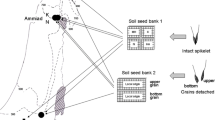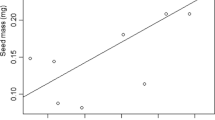Summary
Using the propagules of common milkweed (Asclepias syriaca L.) we tested the predictions that decreasing size may increase dispersal ability, but also decrease the probability of seedling success, of wind-dispersed seeds. In 1982 and 1983 we released seeds from four milkweed clones at two heights in an open field and measured their dispersal distances. In the laboratory we measured falling times in a dead air space, seed mass and area, and coma mass and length of the same seeds. The seeds were later planted in a greenhouse and germination, mortality, and seedling dry mass were recorded.
Seed mass was negatively correlated with dispersal distance in 1982, but not in 1983 under highly variable wind conditions. Coma mass/seed mass ratio was positively correlated with dispersal distance in 1982. During both years seed mass and coma mass/seed mass ratio were highly significantly correlated with falling time in dead air space. However, heavy seeds had superior germination, survivorship, and seedling mass at harvest, and seeds that germinated fell faster in dead air than those that did not. We found substantial variation in seed morphology both among clones and among pods within clones. Propagule falling times in dead air and (in 1982) dispersal distances in the field also differed significantly among clones and pods. The potential therefore exists for differential dispersal and establishment of milkweed genotypes.
Similar content being viewed by others
References
Augspurger CK (1983) Seed dispersal at the tropical tree, Platypodium elegans, and the escape of its seedlings from fungal pathogens. J Ecol 71:759–771
Augspurger CK, Hogan KP (1983) Wind dispersal of fruits with variable seed number in a tropical tree (Lonchocarpus pentaphyllus: Leguminosae). Amer J Bot 70:1031–1037
Bookman SS (1984) Evidence for selective fruit production in Asclepias. Evolution 38:72–86
Cicidiyan MA, Malloch AJC (1982) Effects of seed size on the germination, growth, and competitive ability of Rumex crispus and Rumex obtusifolius. J Ecol 70:227–232
Comins HN, Hamilton WD, May RM (1980) Evolutionarily stable dispersal strategies. J Theor Biol 82:205–230
Geritz SAH, de Jong TJ, Klinkhamer PGL (1984) The efficacy of dispersal in relation to safe site area and seed production. Oecologia (Berl) 62:219–221
Green DS (1980) The terminal velocity and dispersal of spinning samaras. Amer J Bot 67:1218–1227
Howe HV, Smallwood J (1982) Ecology of seed dispersal. Annu Rev Ecol Syst 13:201–228
Howe HF, Richter W (1982) Effects of seed size on seedling size in Virola surinamensis: a within and between tree analysis. Oecologia (Berl) 53:347–351
Janzen DH (1984) Dispersal of small seeds by big herbivores: foliage is the fruit. Amer Natur 123:338–353
Levin DA, Kerster HW (1974) Gene flow in seed plants. Evol Biol 7:139–220
Morse DH, Fritz RS (1983) Contributions of diurnal and nocturnal insects to the pollination of common milkweed (Asclepias syriaca L.) in a pollen-limited system. Oecologia (Berl) 60:190–197
Platt WJ, Weis IM (1977) Resource partitioning and competition within a guild of fugitive prairie plants. Amer Natur 111:479–513
Rabinowitz D, Rapp JK (1981) Dispersal abilities of seven sparse and common grasses from a Missouri prairie. Amer J Bot 68:616–624
SAS Institute, Inc. (1982) SAS Users Guide: Statistics, 1982 Edition. SAS Institute, Inc., Cary, North Carolina, USA
Schaal B (1980) Reproductive capacity and seed size in Lupinus texensis. Amer J Bot 67:703–709
Sheldon JC, Burrows FM (1973) The dispersal effectiveness of the achene-pappus units of selected Compositae in steady winds with convection. New Phytol 72:665–676
Stanton JL (1984) Seed variation in wild radish: effect of seed size on components of seedling and adult fitness. Ecology 65:1105–1112
Waller D (1984) Differences in fitness between seedlings derived from cleistogamous and chasmogamous flowers in Impatiens capensis. Evolution 38:427–440
Werner P, Platt WJ (1976) Ecological relationships of co-occurring goldenrods (Solidago: Compositae). Amer Natur 110:959–971
Wulff R (1982) The physiological and ecological consequences of seed size variation in Desmodium paniculatum. PhD Dissertation, Duke University, Durham, North Carolina, USA
Author information
Authors and Affiliations
Rights and permissions
About this article
Cite this article
Morse, D.H., Schmitt, J. Propagule size, dispersal ability, and seedling performance in Asclepias syriaca . Oecologia 67, 372–379 (1985). https://doi.org/10.1007/BF00384943
Received:
Issue Date:
DOI: https://doi.org/10.1007/BF00384943




